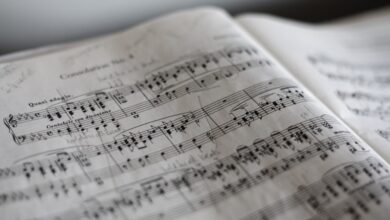Exploring the Impact of Music on Socialization and Peer Relationships

Have you ever wondered how music has the power to bring people together? It’s truly fascinating how a simple melody can elicit strong emotions, forge connections, and shape socialization. In this article, we will delve into the profound impact of music on socialization and peer relationships.
When it comes to socialization, music acts as a universal language that transcends cultural and linguistic barriers. Think about it – whether you’re at a party, a concert, or even just walking down the street with your headphones on, chances are you’ve experienced the spontaneous urge to tap your feet or hum along to a catchy tune. This shared experience creates an instant bond between individuals, facilitating communication and fostering a sense of belonging.
Furthermore, music serves as a powerful emotional conduit. It has the ability to evoke memories and trigger feelings, allowing people to connect on a deeper level. Imagine sitting around a campfire, strumming a guitar, and singing songs with friends. The emotions stirred by the music create a unique atmosphere of camaraderie and intimacy, enhancing social bonds and strengthening friendships.
In the realm of peer relationships, music plays an influential role in shaping identities and group dynamics. Adolescence, in particular, is a time when young people seek acceptance and strive to define themselves. Music preferences often become an important aspect of their self-expression and contribute to the formation of social groups. Whether it’s punk, hip-hop, classical, or any other genre, music can serve as a unifying force, bringing together individuals who share similar tastes and creating a sense of solidarity.
Moreover, music provides a platform for self-discovery and personal growth. Through shared musical experiences, peers can learn from one another, broaden their horizons, and develop empathy and respect for different perspectives. Collaborative activities such as jam sessions or choir performances foster teamwork, encourage cooperation, and cultivate valuable social skills.
Sounds of Harmony: How Music Fosters Stronger Social Bonds among Peers
Introduction:
Have you ever wondered how music has the power to bring people together, transcending boundaries and creating a sense of unity? It’s no secret that music holds a unique ability to touch our souls and forge connections with others. In this article, we will explore how the sounds of harmony can foster stronger social bonds among peers.
Unleashing Emotional Expression:
Music acts as a universal language that allows individuals to express their deepest emotions without uttering a single word. Whether it’s the upbeat tempo of a pop song or the melancholic melody of a classical piece, music resonates with our emotions, providing an avenue for self-expression. When individuals share their musical preferences or engage in collaborative music-making, they not only reveal a part of themselves but also create opportunities for others to understand and relate to their experiences.
Creating Shared Experiences:
Think back to the last time you attended a live concert or sang along with friends around a campfire. The shared experience of music amplifies the joy and creates lasting memories. Through collective participation, individuals form a bond based on a mutual appreciation for the artistry and the emotional connection that music evokes. These shared experiences become the building blocks of stronger social relationships, fostering a sense of belongingness and camaraderie among peers.
Promoting Empathy and Understanding:
Music has the remarkable ability to cultivate empathy and understanding by bridging gaps between diverse individuals. When we listen to different genres or styles of music, we expose ourselves to new perspectives and cultural influences. By embracing this diversity, we develop a broader worldview and learn to appreciate the uniqueness of each person’s musical taste. This openness promotes empathy, allowing us to connect with others on a deeper level and appreciate their individuality.
Enhancing Communication and Collaboration:
Engaging in music-making as a group requires communication and collaboration. Whether it’s playing in a band or singing in a choir, music demands synchronization and coordination among peers. This shared endeavor fosters teamwork, mutual respect, and effective communication skills. As individuals learn to listen, respond, and harmonize with one another, they develop valuable social skills that extend beyond the realm of music.
Conclusion:
In a world often marked by differences, music has the power to unite and create stronger social bonds among peers. Through emotional expression, shared experiences, empathy, and enhanced communication, the sounds of harmony resonate deeply within us, bridging gaps and fostering connections. So, next time you find yourself tapping your foot to a catchy tune or humming along with friends, remember the remarkable impact music can have in bringing people together.
From Beats to Best Friends: Unveiling the Power of Music in Shaping Social Connections
Introduction:
Have you ever wondered how music can transcend boundaries and bring people together? It’s truly remarkable how a simple melody can create a sense of unity and foster deep connections among individuals from all walks of life. Whether it’s singing along to our favorite tunes at a concert or bonding over shared musical interests, music has an incredible power to shape social connections. In this article, we will explore the profound impact of music on human relationships and delve into the reasons behind its ability to forge lasting friendships.
The Rhythm of Connection:
Music has an innate ability to evoke emotions and resonate with our deepest feelings. When we listen to a song that deeply resonates with us, it creates a powerful emotional connection that can be shared with others. Whether it’s the pulsating beat of a dance track or the soulful melodies of a ballad, music speaks to our hearts and allows us to connect with others on a profound level. It serves as a universal language, transcending cultural and linguistic barriers, and uniting people through a mutual appreciation for rhythm and melody.
Shared Experiences:
Attending concerts or music festivals is an exhilarating experience that brings people together in celebration of their favorite artists and genres. The shared excitement, energy, and passion within these spaces create a unique bond among attendees. Strangers become friends as they sing along to the same songs, dance together, and share in the collective euphoria of the moment. These shared experiences not only create lasting memories but also lay the foundation for meaningful connections that extend beyond the concert venue.
Musical Identity:
Our personal taste in music often reflects our identity and values. It serves as a form of self-expression and can act as a magnet, attracting like-minded individuals who share similar musical preferences. Whether it’s bonding over a mutual love for a specific band or engaging in discussions about the latest music releases, these shared interests can open the doors to deep and meaningful friendships. Music becomes a common ground where individuals can understand and support one another, fostering a sense of belonging and camaraderie.
Healing Harmonies:
Music has a therapeutic effect on our minds and emotions. It has the power to uplift our spirits, provide solace during difficult times, and heal emotional wounds. In moments of joy or sorrow, we often turn to music as a source of comfort and support. When we share these vulnerable moments with others, it deepens our connections and creates a bond based on empathy and understanding. The healing harmonies of music can mend broken relationships, bridge gaps, and create an atmosphere of mutual compassion.

Conclusion:
In a world that sometimes feels divided, music serves as a unifying force, connecting people from diverse backgrounds and fostering genuine friendships. Through its ability to evoke emotions, create shared experiences, reflect personal identities, and offer solace, music plays a vital role in shaping social connections. So, next time you find yourself humming along to a familiar tune or swaying to the rhythm of a song, remember the incredible power of music to bring people together, from beats to best friends.
Melodies as Bridges: Examining Music’s Role in Building Inclusive Peer Communities
Have you ever experienced the power of music to bring people together? It’s amazing how a simple melody can transcend boundaries and create connections among individuals from different backgrounds. In this article, we will explore the role of music in building inclusive peer communities and how it fosters a sense of belonging.
Music has an innate ability to touch our emotions and evoke feelings that words alone often cannot convey. When people come together to share and appreciate music, they find common ground, regardless of their differences. It acts as a universal language that unites individuals and breaks down barriers. Whether it’s singing, dancing, or playing instruments, music provides a platform for self-expression and encourages collaboration.

Inclusive peer communities thrive on diversity and acceptance. Music serves as a bridge that connects people with varying cultural, ethnic, and social backgrounds. It allows individuals to celebrate their unique identities while appreciating the richness of others’ experiences. By engaging in musical activities together, individuals develop empathy and understanding, fostering a sense of unity and solidarity within the community.

Moreover, music promotes active listening and communication skills. In a world where misunderstandings and conflicts are prevalent, the power of truly listening to one another cannot be underestimated. Playing in a band or singing in a choir requires musicians to synchronize and cooperate, enhancing their ability to work collaboratively towards a common goal. These skills translate beyond the realm of music, enabling individuals to communicate effectively and resolve conflicts peacefully in their everyday lives.
Music also provides a means for individuals to express their thoughts and emotions authentically. It serves as a therapeutic outlet, allowing people to process their experiences and connect with others who may have gone through similar struggles. In this way, music becomes a catalyst for healing and resilience within the community.
Music plays a vital role in building inclusive peer communities. It acts as a powerful medium that fosters connections, promotes empathy, and enhances communication skills among individuals from diverse backgrounds. By embracing the melodies that unite us, we can create communities where everyone feels valued and included. So, let the music be our bridge to a more inclusive and harmonious world.
Tuning In Together: The Surprising Influence of Music on Peer Group Dynamics

Have you ever wondered how music can bring people together and shape the dynamics of a peer group? It’s truly fascinating how a simple melody or catchy beat can create a powerful connection among individuals, transcending barriers and fostering a sense of belonging. In this article, we’ll explore the surprising influence of music on peer group dynamics and delve into the reasons behind its unifying power.

Music has an innate ability to evoke emotions within us. Whether it’s a heart-wrenching ballad or an upbeat dance track, the melodies and lyrics have a way of resonating with our innermost feelings. When shared with others in a peer group, these emotional connections intertwine, forming a collective experience that amplifies the bond between individuals. It’s almost like a musical language that everyone understands, regardless of background or differences.
Think about those moments when you attended a concert or sang along to your favorite songs with friends. The energy in the air, the synchronized swaying of bodies, and the chorus of voices all contribute to an atmosphere of togetherness. Music becomes the common thread that weaves through the social fabric, forging lasting memories and strengthening the relationships within the peer group.
Beyond its emotional influence, music also serves as a catalyst for self-expression. Each person brings their unique tastes and preferences to the table, creating a diverse mosaic of musical styles within a peer group. This diversity sparks discussions, debates, and sharing of new discoveries, enhancing the overall dynamic. In turn, this exchange of musical experiences fosters openness, understanding, and acceptance among peers, breaking down barriers and promoting a sense of unity.
Additionally, music can act as a time machine, transporting individuals back to specific moments in their lives. Certain songs or genres have the power to evoke vivid memories, reminding us of shared experiences and bonding rituals within the peer group. It’s like having a soundtrack to our lives, with each song representing a chapter in our collective story.
Music possesses an awe-inspiring influence on peer group dynamics. Its ability to evoke emotions, create shared experiences, foster self-expression, and serve as a nostalgic time capsule makes it a powerful tool for connection and unity. So, next time you gather with your peers, consider the magic of music and tune in together to witness its surprising impact on your bond. Let the melodies play, and let the rhythm guide you on an unforgettable journey of togetherness.




